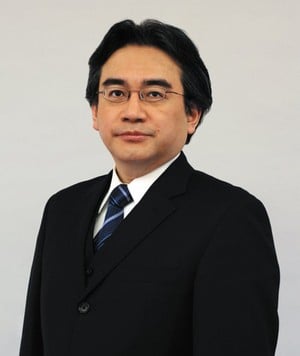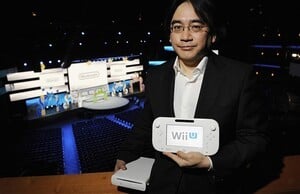
Today brings us another Birthday for one of Nintendo's most well-known figures, with President Satoru Iwata turning 53 today. It would seem that, should he want to, Iwata-san will be able to continue in his current role for many years to come.
Satoru Iwata had a passion for video game development from a young age, deciding to study Computer Science at the Tokyo Institute of Technology. His first full-time job was with HAL Laboratory in 1982, though in the 1980s he played prominent roles as a freelancer on Nintendo titles such as Balloon Fight and NES Open Tournament Golf. He was heavily involved in bringing Masahiro Sakurai's creation, Kirby, to the market, a major franchise for which he can rightly claim some credit.
After a successful decade Satoru Iwata was appointed President of HAL in 1993, with the company facing financial difficulties. By the time he left to take up a role as Head of Nintendo's Corporate Planning Division in 2000, he'd been credited for leading the company to greater financial security. Such was Iwata-san's success in his new role at Nintendo that Hiroshi Yamauchi, Nintendo's long-term President, chose him as his successor as President of Nintendo in 2002. Yamauchi said the following (via IGN):
Taking into account the things I've encountered in my experiences as Nintendo president, I have come to the conclusion that it requires a special talent to manage a company in this industry. I selected Iwata-san based on that criteria. Over the long-term I don't know whether Iwata-san will maintain Nintendo's position or lead the company to even greater heights of success. At the very least, I believe him to be the best person for the job.
Satoru Iwata was the first President of Nintendo not related to the Yamauchi family through blood or marriage, and has gone on to lead Nintendo to a strategy of innovative consoles and new gaming experiences, with less focus on graphical power. It's a strategy that led to major success with DS — the highest selling handheld of all time — and Wii, which is the biggest selling home console of its generation at the time of writing. The focus on two screens and motion controls, with modest hardware capabilities in terms of graphical output, was considered a gamble, yet it led to a period of impressive growth and profits for the company.

The release of the 3DS handheld, along with the late-lifespan struggles of the Wii, did lead to more difficult times for the Nintendo President. Such was the drop in sales of 3DS that Nintendo implemented a significant price-cut months after launch, with Iwata-san apologising to early-adopters and taking — along with fellow executives — a substantial pay-cut. The fortunes of 3DS have improved with well over 20 million units now sold and each now generating a profit upon sale. It's a vital period for Nintendo, with Wii U hitting the home console market with its GamePad controller, the emphasis once again on controls and game experience innovation. Early sales of Wii U have been close to sell-outs, and Iwata-san stated in the most recent financial reports that he expects the company's recent losses to revert to a small profit this financial year.
Since taking over the helm of Nintendo in 2002, Satoru Iwata has overseen a change of focus with Nintendo, bringing almost unprecedented success with the DS/Wii era. New challenges are clearly ahead with a continued push for 3DS success and with Wii U's arrival, though Nintendo's impressive performance in the past decade leaves the company in solid financial waters, for which much credit is surely due to its fourth President.





Comments 53
happy birthday dude
Happy Birthday!
Aww! What a guy! Happy Birthday!
Still have respect for the fact that he took a pay cut with the 3DS release troubles.
Happy Birthday Iwata!
Happy birthday!
Happy birthday!
And many, many more!
Happy Birthday, Iwata!
Yamauchi was very much a business man who looked into many venues, with video gaming hitting it big by seizing the opportunity after the video game crash of 1983. He himself was not very involved in the actual industry so much as business concerns, whereas Iwata proved himself both as an industry talent and business leader.
Happy Birthday to Iwata, looking forward to seeing what more goodies Nintendo will be bringing over the years.
Why not go play Wario Ware Smooth Moves now and see his cameo in 9-Volt's scenario?
Iwata is my favorite president of any company. Not only did he save HAL Labs & Kirby, (both of which I couldn't go without!), but he has done so much good for Nintendo and us fans.
Happy birthday, Satoru Iwata!
Happy birthday Iwata! I hope you have an excellent birthday full of happiness and laughs. (laughs)
P.S. He does not look 53.
When Satoru Iwata decides to step down as president, I'm sure Just For Men will be eagerly trying to recruit him as a spokesperson.
Iwata stopped by the house yesterday. He demanded a slice of birthday cake. I said, "It isn't your birthday until tomorrow."
He then stood in the corner and stared at me without blinking until my nipples fell off. It took four and a half hours.
Many happy returns to Mr Iwata, best wishes for good health and prosperity.
Happy Birthday Iwata-san!
May much favor be yours from the god of your choice ! Low bow!
May good fortune be yours and all your video game creations and creators..
As for myself , I enjoy the games and game systems produced by your company. I have but one wish (game system wise).... To get a 3dsxl someday. I am an older american and live on a budget...soooo it may take some time. Right now I have a dsixl and love it. Please keep the dsiware comming !
Many blessings from my God as well ( Jesus that is ).
Yours, Joygame51
Happy Birthday, Iwata-san! May you continue to lead Nintendo into greatness.
@Philip_J_Reed - Let me guess, after that he said, "And no one will ever believe you (laughs)".
I wish you the happiest birthday ever, Mr. Iwata! ^_^
Happy Birthday Iwata!
He looks young. Happy birthday Iwata San!
Happy Birthday Iwata!
That's all he is? I guess that puts Shiggy close to 60 maybe?
Happy B-Day Iwata, don't forget to invite Masahiro Sakurai, generic Balloon Fighter, and Kirby to some cake.
Long Live IWATA
happy b-day Iwata !
Happy Birthday Iwata!
Happy birthday, sir, and i hope for many many more.
He looks younger.
Happy Birthday Iwata!
誕生日おめでとう岩田!(in Japanese)
HAPPY BIRTHDAYYYYYYY
Happy birthday.
Have a very Happy Birthday:D And DON'T DIE SOON! You still got work Iwata...JK but really have a great bday:)
@MeloMan
Shigeru Miyamoto is 60, just turned 60 not to long ago. He does look much younger.
Happy Birthday, Iwata-san!
May God be at your side!
Happy Birthday Iwata! Thanks for always being a character when seen in broadcasts, you really make a change in pace to the usually boring company executive trend. Thanks for all you've done for Nintendo as well, along with the industry and us fans.
Happy Birthday, Iwata-san!
HAPPY BIRTH DAY!!!!!XD
awwww Happy Birthday! I respect him so much for what he's done for Nintendo
Happy Birthday Mr Iwata! I hope youbhave a wonderful time!
Happy birthday, Iwata-san! Many happy returns!
It's so cool we have birthdays only five days apart. <3
Happy Birthday Iwata!!!!!
Happy Birthday! Many bananas to you this day.
Happy Birthday, Iwata-san!
Happy birthday, Iwata-san!
I admire the man, seriously.
The fact that he provides us with the insights of videogame development, secets, concepts and whatnot via Iwata Asks is, by itself, incredible.
What I really like about him is that he does things he doesn't necessarily have to do--like videos such as the Wii U unboxing on YouTube. I mean, they could hire someone else to do such promotional videos. But Iwata does them himself.
I like his humility and playfulness a lot--I'm really glad that he is the president of Nintendo.
Happy birthday greatest leader of a company ever!
Happy Birthday Mr. Iwata! Hope you will have a good, happy year (^_^)
Happy Birthday Mr Legend Iwata.
Happy Birthday Mr. Iwata. He has led Nintendo to new heights of greatness and will hopefully continue to do so for a long time.
Happy Birthday Iwata!
This may be late but Happy Birthday Iwata!
Late happy birthday Iwata!
Sadly, Iwata did not live much longer... R.I.P. =(
Show Comments
Leave A Comment
Hold on there, you need to login to post a comment...